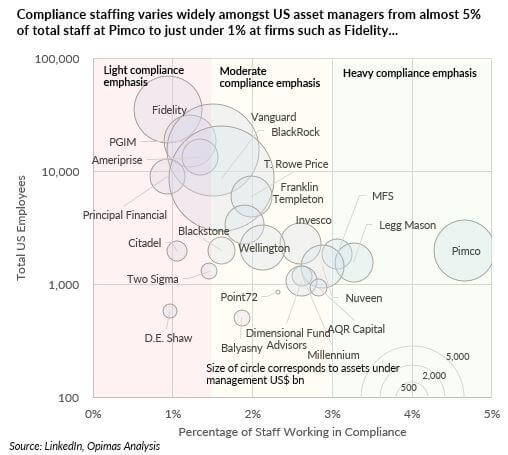Are Compliance Teams Feeling the Impact of RegTech?
March 11th, 2019

Recently, Octavio Marenzi, CEO of leading research and advisory firm Opimas, posted the chart below on LinkedIn, which illustrated the disparity between the staffing size of compliance programs across US asset management firms. As part of Opimas’s recently published research report, “Outsourcing at Asset Managers -2022”, the simple graphic pulled in a flood of inquiries about the findings – the findings weren’t necessarily what some readers may have expected.
Almost immediately after his post went live, debating comments appeared, questioning why such incongruity occurs and how did Opimas explain this seemingly negative correlation between size and compliance staffing. Surprisingly, the chart shows, larger firms tend to have smaller compliance staffs proportionally to its size? Does this statistic mean that some firms merely care about compliance vastly more than others? I think that the answer goes deeper than that? Something to consider as part of this equation that may not be clear by just looking at chart metrics is the impact and presence of modern RegTech on the operations at each type of organization.
The Impact of Machine Learning
Machine learning and automation are no longer just buzzwords; these technologies are rapidly becoming the new normal particularly at financial services organizations. Gone are the days when regulators would allow top and mid-tier firms to use Excel spreadsheets for monitoring trading. According to a report by Juniper Research, it is estimated that by 2023, RegTech will account for 40 percent of businesses total compliance spending. This will allow firms to empower their employees to do the analyst jobs they were hired to do, instead of constantly trying to find buried information or tackle a backlog of requests. Looking through that lens, it is unsurprising that many larger firms have leaner compliance departments, since they can more easily afford the cutting-edge technology required to dispense with manual-based processes.

If that is the case, then the obvious follow up question is “why now”? MiFID II may only now be hitting its stride in Europe, but the United States has grappled with Dodd-Frank for a decade, broker dealers are arguably under the highest level of scrutiny in history, and the movement toward fixed fee investment advisors continues as the calls for fiduciary regulations grows. Why is it now that RegTech is suddenly causing a tangible metamorphosis of compliance programs? The answer lies in effectiveness. Not the effectiveness of the individuals protecting financial markets from the outside or within, but the effectiveness of regulation itself.
Financial regulation has existed for as long as man could trade, and as the markets evolved over time so too have the obligations placed on the traders participating within them. With every new market, product, and asset class comes greater responsibility to obtain corresponding data which, in theory, provides equity, transparency, and stability. Today, regulations require the capture of more information than a manual process can physically handle. More data was created in 2017 than the previous 5,000 years of humanity. While not all that data was trading activity, – try telling that to a compliance officer tasked with sorting through massive amounts of data.
The totality of this information must be compiled, reviewed, and reported and yet market manipulation still occurs. Insider trading still happens. If greater headcount does not eliminate manipulation, and amassing more information does not eliminate manipulation, than can the objective of regulation ever be truly realized? For the first time in history the answer may be yes.
Ultimately, we are witnessing a unique nexus between regulation requiring surveillance, and the implementation of technology capable of making the goals of financial regulation a reality. Firm’s investments into RegTech will allow for even leaner teams, but significantly more effective ones.
Using the information required by global regulations, coupled with faster computers and supplicated software, modern compliance programs will be able to proactively monitor for malicious behavior instead of simply reacting to it. In the years to come RegTech implementation and evolution will alter the Opimas compliance staffing chart above and most, if not all asset managers will be huddled together in the same quadrant.




